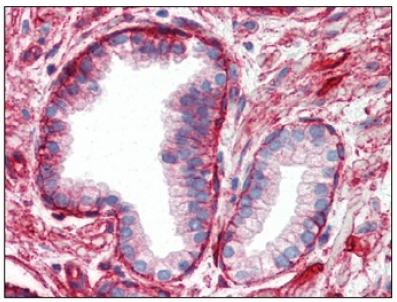Integrin beta 1 (ITGB1) Mouse Monoclonal Antibody [Clone ID: JB1B]
Specifications
| Product Data | |
| Clone Name | JB1B |
| Applications | ELISA, FC, IHC, IP, WB |
| Recommended Dilution | ELISA: 0.1-1 µg/ml. Western Blot. Flow Cytometry: 1 µg/106 cells. Immunoprecipitation: 1-5 µg/ml. Immunohistochemistry on Frozen Sections: 5 µg/ml. Immunohistochemistry on Paraffin Sections: 10 µg/ml after heat-induced antigen retrieval. Functional Assays: The removal of Sodium Azide is recommended. |
| Reactivities | Human, Monkey |
| Host | Mouse |
| Isotype | IgG2a |
| Clonality | Monoclonal |
| Immunogen | Purified Human beta-1 integrin. |
| Specificity | This antibody reacts with Human CD29/Integrin beta-1 as confirmed with beta-1 transfectants and by reciprocal preclearing of beta-1 reactivity with anti-beta-1. The antibody stimulates the adherence of several cell types. Does not react with Rat. |
| Formulation | PBS State: Ig Fraction State: Liquid Ig fraction Preservative: 0.09% Sodium Azide |
| Concentration | lot specific |
| Purification | Ammonium Sulphate Precipitation |
| Storage | Store undiluted at 2-8°C for one month or (in aliquots) at -20°C for longer. Avoid repeated freezing and thawing. |
| Stability | Shelf life: one year from despatch |
| Gene Name | integrin subunit beta 1 |
| Database Link | |
| Background | Integrin beta 1, also known as CD29, is a 130 kDa transmembrane glycoprotein that forms noncovalent complexes with various Integrin alpha subunits (including alpha 1, alpha 2, alpha 3, alpha 4, alpha 5, and alpha 6, also known as CD49a, CD49b, CD49c, CD49d, CD49e, and CD49f, respectively) to form the functional receptors that bind to specific extracellular matrix proteins. Integrin receptors are involved in the regulation of a variety of important biological functions, including embryonic development, wound repair, hemostasis, and prevention of programmed cell death. They are also implicated in abnormal pathological states such as tumor directed angiogenesis, tumor cell growth, and metastasis. These heterodimeric receptors bridge the cytoplasmic actin cytoskeleton with proteins present in the extracellular matrix and/or on adjacent cells. The clustering of integrins on a cell surface leads to the formation of focal contacts. Interactions between integrins and the extracellular matrix lead to activation of signal transduction pathways and regulation of gene expression. In case of HIV-1 infection, the interaction with extracellular viral Tat protein seems to enhance angiogenesis in Kaposi's sarcoma lesions. |
| Synonyms | Fibronectin receptor subunit beta, Integrin VLA-4 subunit beta, ITGB1, FNRB, MDF2, MSK12 |
| Reference Data | |
Documents
| Product Manuals |
| FAQs |
{0} Product Review(s)
0 Product Review(s)
Submit review
Be the first one to submit a review
Product Citations
*Delivery time may vary from web posted schedule. Occasional delays may occur due to unforeseen
complexities in the preparation of your product. International customers may expect an additional 1-2 weeks
in shipping.






























































































































































































































































 Germany
Germany
 Japan
Japan
 United Kingdom
United Kingdom
 China
China



